THE Installation of HRH, the Prince of Wales as M.W.G.M, is very likely to occupy the attention of the public for some time to come.
Therefore we have taken the oportunity to outline a brief history on the relationship between the British Monarchy and the craft
– The Freemason’s Chronicle 20th March , 1875, with additional source material

Left:Albert Edward, Prince of Wales, as a Grand Master of the United Grand Lodge of England
Centre: photograph of Prince of Wales
Right: Portrait of King Edward VII (1841-1910)
IMAGE LINKED: wikimedia Attribution 4.0 International (CC BY 4.0) and GOULD, The History of Freemasonry
Edward VII (Albert Edward; 9 November 1841 – 6 May 1910) was King of the United Kingdom of Great Britain and Ireland and the British Dominions, and Emperor of India from 22 January 1901 until his death in 1910.
The eldest son of Queen Victoria and Prince Albert of Saxe-Coburg and Gotha, and nicknamed “Bertie”, Edward was related to royalty throughout Europe.
He was Prince of Wales and heir apparent to the British throne for almost 60 years. During the long reign of his mother, he was largely excluded from political influence and came to personify the fashionable, leisured elite.
He travelled throughout Britain performing ceremonial public duties, and represented Britain on visits abroad. His tours of North America in 1860 and of the Indian subcontinent in 1875 proved popular successes, but despite public approval, his reputation as a playboy prince soured his relationship with his mother.
THE Installation of HRH, the Prince of Wales as M.W.G.M, is very likely to occupy the attention of the public for some time to come.
There will, in fact, in the Masonic world, be hardly any other subject of general interest not only between now and the 28th April, 1875 the day fixed for the important ceremony, but for some considerable period after.
It may be as well therefore to place our readers account of the past connection of the Royal Family with our Order.
It is not, perhaps, generally known, even among Masons, that His Royal Highness is the third Prince of Wales of the Hanoverian family who has been a member of the Brotherhood.
Twenty years only had elapsed since the revival of Freemasonry in 1717, when Frederick Prince of Wales, son of George II, and father of George III ., became a Mason.

Frederick Lewis, Prince of Wales (1707-1751)
IMAGE LINKED: wikimedia Attribution 4.0 International (CC BY 4.0)
Frederick, Prince of Wales, KG (Frederick Louis, German: Friedrich Ludwig; 31 January 1707 – 31 March 1751), was heir apparent to the British throne from 1727 until his death from a lung injury at the age of 44.
He was the eldest but estranged son of King George II and Caroline of Ansbach, and the father of King George III.
Under the Act of Settlement passed by the English Parliament in 1701, Frederick was fourth in the line of succession to the British throne at birth, after his great-grandmother, paternal grandfather and father.
He moved to Great Britain following the accession of his father, and was created Prince of Wales.
He predeceased his father, however, and upon the latter’s death on 25 October 1760, the throne passed to Prince Frederick’s eldest son, George III.
He was initiated, during the Grand Mastership (1737-1738) of the Edward Bligh, 2nd Earl of Darnley (9 November 1715 – 22 July 1747), at an occasional Lodge, specially convened at the Palace of Kew, at which Dr, Desaguliers presided as W.M, and His Royal Highness passed at the same Lodge.
At a subsequent Lodge, specially convened for the purpose, at the same place, a short time after, His Royal Highness was raised to the degree of Master Mason.
This happened in 1737, but unfortunately the prince died in 1751, just at the time when his connection with the Craft might have been of essential service to it.

Portrait of Edward Augustus, Duke of York and Albany (1739-67)
IMAGE LINKED: wikimedia Attribution 4.0 International (CC BY 4.0)
Prince Edward, Duke of York and Albany, KG, PC, FRS (Edward Augustus; 25 March 1739 – 17 September 1767) was the younger brother of George III of the United Kingdom and the second son of Frederick, Prince of Wales, and Princess Augusta of Saxe-Gotha.
In 1765, Prince Edward, Duke of York and Albany, according to Findel, became a Mason, at Berlin.

left: HRH Prince Henry, Duke of Cumberland and Strathearn
right: HRH Prince William, 1st Duke of Gloucester
IMAGE LINKED: wikimedia Attribution 4.0 International (CC BY 4.0)
Prince Henry, Duke of Cumberland and Strathearn (Henry Frederick;[1] 7 November 1745 – 18 September 1790) was the sixth child and fourth son of Frederick, Prince of Wales, and Princess Augusta of Saxe-Gotha, and a younger brother of George III.
Prince William, Duke of Gloucester and Edinburgh, KG PC FRS (25 November 1743 – 25 August 1805), was a grandson of King George II and a younger brother of King George III of the United Kingdom.
While in the following year, during the Mastership (1764-1767) of Lord Blaney, the Duke of Gloucester and Duke of Cumberland, brothers of George III, were initiated, the former at an occasional Lodge, holden at the Horn Tavern, Westminster, on the 16th February 1786, at which Lord Blaney presided in person; the latter at an occasional Lodge, at the Thatched House Tavern, in St, James ‘ s Street, under the presidency of General Salter.
The rank of Past Grand Master was assigned to these Princes. In 1782 the Duke of Cumberland was elected Grand Master, the privilege being then for the first time granted to a Prince of the Blood of nominating a peer of the realm to be acting Grand Master.
His Royal Highness continued to preside over the Order until his death in 1790, and was succeeded by H.R.H, the Prince of Wales, afterwards George IV.
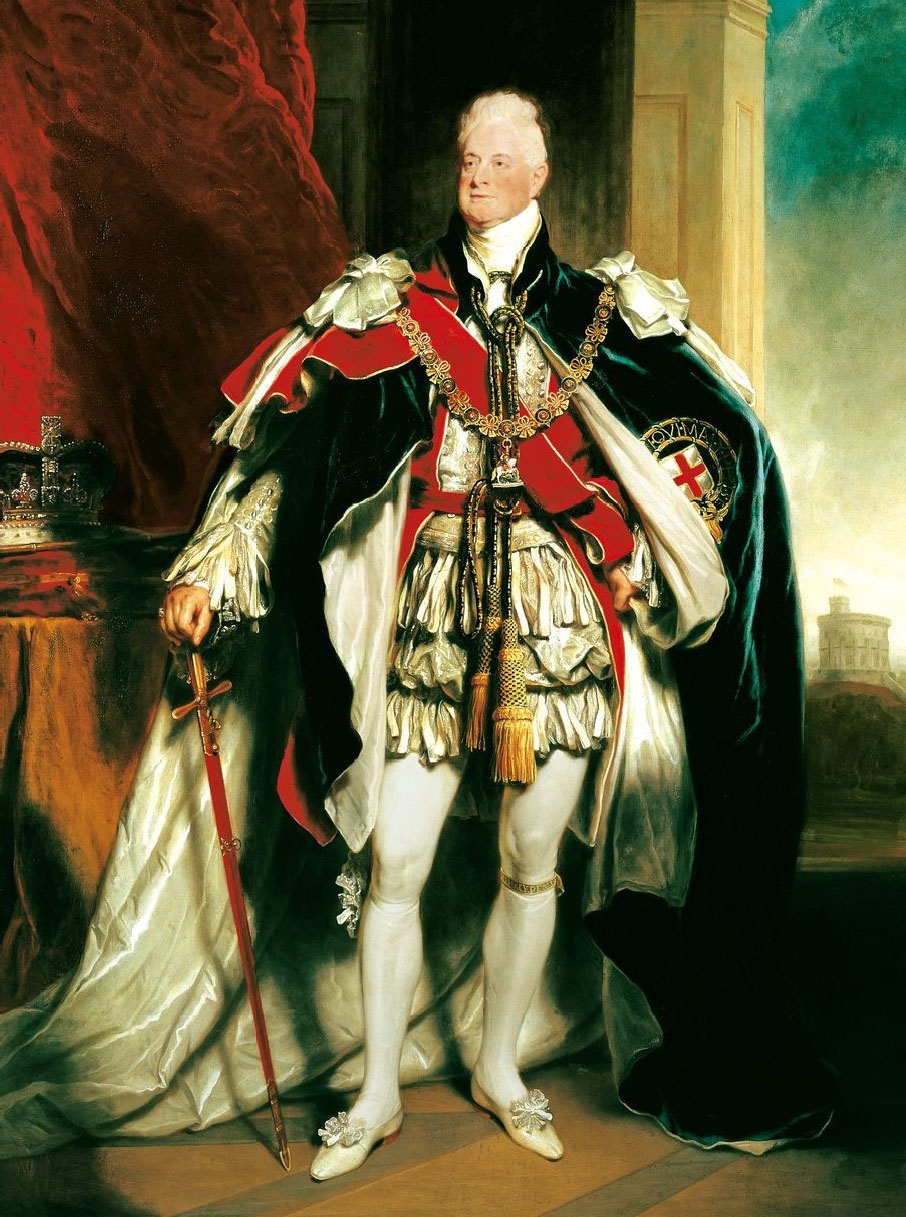
The King is here shown in Garter Robes with his right hand on his sword and St Edward’s Crown and sceptre beside him
IMAGE LINKED: wikimedia Attribution 4.0 International (CC BY 4.0)
William IV (William Henry; 21 August 1765 – 20 June 1837) was King of the United Kingdom of Great Britain and Ireland and King of Hanover from 26 June 1830 until his death in 1837.
The third son of George III, William succeeded his elder brother George IV, becoming the last king and penultimate monarch of Britain’s House of Hanover.
In 1786, Prince William Henry, Duke of Clarence, afterwards William IV , was initiated at Lodge 86, held at the Prince George Inn, Plymouth.
He became W.M. of Prince of Wales’s Lodge in 1828, on the death of the Duke of York, and on his accession to the throne, Grand Patron.

King George IV depicted wearing coronation robes and four collars of chivalric orders: the Golden Fleece, Royal Guelphic, Bath and Garter.
IMAGE LINKED: wikimedia Attribution 4.0 International (CC BY 4.0)
George IV (George Augustus Frederick; 12 August 1762 – 26 June 1830) was King of the United Kingdom of Great Britain and Ireland and King of Hanover from the death of his father, King George III, on 29 January 1820 until his own death ten years later. He had already been serving as Prince Regent since 5 February 1811, during his father’s final mental illness.
On Thursday, 6th February 1787, H.R.H, the Prince of Wales ( George IV ) was made a Mason, at an occasional Lodge convened for the purpose at the Star and Garter Tavern, Pall Mall, over which H.R.H, the Duke of Cumberland, Grand Master, presided.

Prince Frederick, Duke of York and Albany KG GCB GCH
IMAGE LINKED: wikimedia Attribution 4.0 International (CC BY 4.0)
Prince Frederick, Duke of York and Albany KG GCB GCH (Frederick Augustus; 16 August 1763 – 5 January 1827) was the second son of George III, King of the United Kingdom and Hanover, and his consort Charlotte of Mecklenburg-Strelitz.
A soldier by profession, from 1764 to 1803 he was Prince-Bishop of Osnabrück in the Holy Roman Empire.
From the death of his father in 1820 until his own death in 1827 he was the heir presumptive to his elder brother, George IV, in both the United Kingdom of Great Britain and Ireland and the Kingdom of Hanover.
H, R, H, the Duke of York was initiated at a special Lodge convened at the same place for the purpose, on the 21st November of the same year, the Grand Master again presiding in person, and His Royal Highness the Prince of Wales assisting at the ceremony of initiation.
Grand Master His Royal Highness the Duke of Cumberland died in September 1790, about the last public act at which he assisted being the reinstatement, after a separation of ten years, of the Lodge of Antiquity in all its Masonic privileges.
On the 24th November 1790, H.R.H, the Prince of Wales was elected his successor in the Grand Mastership, (1792 – 1813) appointing Lord Moira, afterwards Marquis of Hastings’, as Acting Grand Master, but it was not until the 2nd May 1792, when the Grand Feast was held at the Freemasons’ Hall, that His Royal Highness was duly installed in his office.

left: Portrait of Prince Augustus Frederick, Duke of Sussex (1773-1843)
right: Portrait of Prince Edward Augustus, Duke of Kent (1767–1820)
IMAGE LINKED: wikimedia Attribution 4.0 International (CC BY 4.0)
Prince Augustus Frederick, Duke of Sussex, KG, KT, GCB, GCH, PRS, FRSA (27 January 1773 – 21 April 1843) was the sixth son and ninth child of King George III and his queen consort, Charlotte of Mecklenburg-Strelitz.
He was the only surviving son of George III who did not pursue an army or navy career.
He was known for his liberal views, which included reform of Parliament, abolition of the slave trade, Catholic Emancipation, and the removal of existing civil restrictions on Jews and Dissenters.
Prince Edward, Duke of Kent and Strathearn, KG, KP, GCB, GCH, PC (Edward Augustus; 2 November 1767 – 23 January 1820) was the fourth son and fifth child of King George III. His only child became Queen Victoria.
Mean time, it had been announced in Grand Lodge, 19th February 1790, that H.R.H, the Duke of Kent had been regularly initiated in the Union Lodge at Geneva, and that H.R.H, the Duke of Sussex had also been initiated at a Lodge at Berlin.

Ernst August von Hannover (1771-1851)
IMAGE LINKED: wikimedia Attribution 4.0 International (CC BY 4.0)
Ernest Augustus (German: Ernst August; 5 June 1771 – 18 November 1851) was King of Hanover from 20 June 1837 until his death in 1851.
As the fifth son of King George III of the United Kingdom and Hanover, initially he seemed unlikely to become a monarch, but none of his elder brothers had a legitimate son.
When his older brother William IV, who ruled both kingdoms, died in 1837, his niece Victoria inherited the British throne under British succession law, while Ernest succeeded in Hanover under Salic law, which barred women from the succession, thus ending the personal union between Britain and Hanover that had begun in 1714.
The Duke of Cumberland, afterwards King of Hanover, and Gloucester, were also initiated, at a later period.
H.R.H, the Prince of Wales having subsequently been chosen Grand Master of Scotland, in 1806, remained Grand Master until 1813, when, being Regent, he resigned the position to his Royal Brother of Sussex, who soon after became Grand Master of the United Grand Lodge of Masons ( 1813 ).
In 1813 H.R.H, the Duke of Kent was chosen Grand Master of’ the York or Ancient Masons, and it was by the united efforts of these two Dukes, of Sussex and Kent, that the healing of the great schism was at last happily effected.
The career as Grand Master of H.R.H, Duke of Sussex, is it not written in the chronicles of Masonry. Suffice it that no one could have devoted himself more entirely to furthering the interests of the Craft.
During his long reign of 30 years, Freemasonry continued to flourish, and our hope and expectation is that, under the beneficent reign of his Royal grandnephew, the present M.W.G.M, the success of the Order may be as prominent and as continuous as it was during the auspicious Grand Mastership (1813 – 1843) of H.R.H, the Duke of Sussex .

Since this article was first published in 1875, HRH the Prince of Wales become Grand Master of the United Grand Lodge of England (1875 – 1901 )
The following Royal Princes have held the position of Grand Master of United Grand Lodge of England.

left: Prince Arthur, Duke of Connaught and Strathearn (UGLE GM 1901–1939)
centre: Prince George, Duke of Kent (UGLE GM 1939–1942)
Prince Edward, Duke of Kent (UGLE GM 1967–present)
IMAGE LINKED: wikimedia Attribution 4.0 International (CC BY 4.0)
Prince Arthur, Duke of Connaught and Strathearn (Arthur William Patrick Albert; 1 May 1850 – 16 January 1942), was the seventh child and third son of Queen Victoria and Prince Albert.
He served as the Governor General of Canada, the tenth since Canadian Confederation and the only British prince to do so.
In 1910 he was appointed Grand Prior of the Order of St John and held this position until 1939.
Prince George, Duke of Kent, KG, KT, GCMG, GCVO (George Edward Alexander Edmund; 20 December 1902 – 25 August 1942) was a member of the British royal family, the fourth son of King George V and Queen Mary. He was a younger brother of kings Edward VIII and George VI.
He served in the Royal Navy in the 1920s and then briefly as a civil servant. He became Duke of Kent in 1934. In the late 1930s he served as an RAF officer, initially as a staff officer at RAF Training Command and then, from July 1941, as a staff officer in the Welfare Section of the RAF Inspector General’s Staff. He was killed in a military air-crash on 25 August 1942.
Prince Edward, Duke of Kent, KG, GCMG, GCVO, CD, ADC (Edward George Nicholas Paul Patrick; born 9 October 1935) is a member of the British royal family.
He is a first cousin of Queen Elizabeth II through their fathers, Prince George, Duke of Kent, and King George VI. Edward’s mother Princess Marina of Greece and Denmark was also a first cousin of the Queen’s husband Prince Philip, Duke of Edinburgh.
Prince Edward has held the title of Duke of Kent for nearly 80 years, since the age of six, after the death of his father in a plane crash in 1942. Edward carries out engagements on behalf of the Queen and is involved with over 140 charitable organisations.
– Source Wikipedia
 The Freemasons Chronicle, a weekly record of masonic intelligence, was first published 2nd January 1875 London, England as an independent weekly journal of masonic interest and continued for 27 years.
The Freemasons Chronicle, a weekly record of masonic intelligence, was first published 2nd January 1875 London, England as an independent weekly journal of masonic interest and continued for 27 years.
It should be the business of a journal devoted to the interests of the Order to attempt the removal of prejudices such as these, which, though they may have little perceptible influence upon the prosperity of the Fraternity, yet have the effect of preventing timid or ill-informed persons from enlisting under its banner.
It will not only attempt to keep pace with the growing literary requirements of the day, but it will seek to exhibit the Order to the non-Masonic world divested of its technical details, and clothed in the garb of Charity and Brotherly Love.
The questions of the hour, which exercise the minds of thoughtful men, will be handled freely and broadly, without any tinge of political or sectarian bias.
The memoranda of Masonic gatherings which will appear from week to week, will be full and accurate; and as free interchange of opinion is one of the best signs of life and vigour in any society, ample scope will be given for Correspondence on topics of interest to the Order.
If we may venture upon a new rendering of words which recent events have made memorable, we will say here, once and for all, that we will be keen men of business, and will spare no effort, consistent with honour, to achieve commercial success; but first, and before all things, we will prove to our brethren and the world that we are FREEMASONS.
Recent Articles: The Freemason's Chronicle
 Operative And Speculative Masonry Explore the fascinating transition from Operative to Speculative Masonry in our latest post. Discover historical insights from Augustus C. L. Arnold and Rev. Wm. P. Strickland, shedding light on Freemasonry's evolution and its enduring principles. Dive into the rich history and significant milestones that shaped modern Freemasonry. - The Freemason's Chronicle - 2 September 1876 |
 Discover the true essence of Freemasonry, an ancient order founded on the profound principles of love for God and man. It's a call to rise above mere appearances, to embody genuine virtue and benevolence, transcending societal pretense. Embrace the transformative power of simplicity, and let the authentic glories of Freemasonry inspire your path. |
 Discover the intriguing story of a man who became a Mason but openly professed his dislike for the institution. Unravel the peculiar circumstances that led him down this path and explore the unexpected consequences that followed. Dive into this thought-provoking account that challenges our notions of loyalty and reveals the complexities of human nature within the Masonic fraternity. |
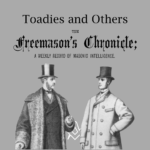 In the realm of Masonry, the principles of equality and respect are paramount. Yet, the presence of toadies—those who obsequiously seek favour from the influential—threatens these ideals. While Masonry embraces diverse beliefs and backgrounds, it rejects the sycophantic behaviours of toadies, flunkeys, and tuft-hunters, urging members to uphold genuine respect and self-worth. The Freemason's Chronicle - 22nd January 1876 |
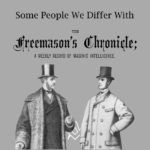 Unveiling the Unpleasant: Some People We Differ With Discover the intriguing dynamics of quarrels within the Masonic brotherhood. From the cantankerous to the litigious, the peevish to the vengeful, delve into the characters that challenge fraternal harmony. Explore their motives, temperaments, and the art of navigating disputes with these fascinating brethren. Brace yourself for a riveting journey into the world of conflicting personalities. |
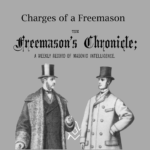 Unravelling the Masonic Mystique: A Deep Dive into the Freemasons' Charges - Explore the intricate world of Freemasonry, its principles, rituals, and the mechanisms for resolving internal disputes. Discover how this ancient fraternity fosters unity, promotes moral conduct, and upholds the sanctity of its secrets, while navigating the complexities of modern society. - The Freemason's Chronicle - 4 December 1875 |
 Unlock the hidden lessons of Masonic Studies! Don't settle for superficial knowledge or mere rituals. Discover the true depth and meaning behind Freemasonry. Expand your understanding of Tracing-Boards, Lectures, and more. Join regular Lodges of Instruction to enhance your Masonic journey. Become a knowledgeable Freemason, not just a token-bearer. Unleash the power of true Masonic wisdom today! |
 Uncover the incredible story of how Masonry saved the life of a Crimean War foot soldier in this historical and masonic account. Through the first hand experience of a soldier engaged in fierce hand-to-hand combat, witness the fateful encounter with a Russian Freemason that changed the course of his life. Learn how brotherhood and a deep dedication to the craft can lead to unforeseen and life-saving circumstances on the battlefield. |
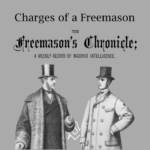 The Freemason's Chronicle - Charges of a Freemason The secrets of Masonry are the exclusive property of the Craft, and can never be communicated to one who is a mere labourer and not an accepted Mason. Hence, no labourer, that is, one who has not been regularly initiated in a legal Lodge. Article first published in The Freemason's Chronicle, 27 November 1875 |
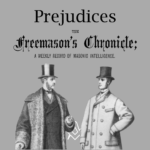 The Freemason's Chronicle - Prejudices Prejudices are partial judgments in favour of, or against certain persons or things, and, for convenience sake, may be ranged in two categories—those which are, comparatively speaking, harmless, and those which are harmful. Article first published in The Freemason's Chronicle, Oct. 2 1875. |
 The Freemason's Chronicle - Cliques Is Freemasonry - a Clique ? Man has been defined as a gregarious animal, but in his highly civilised condition he is gregarious only to a limited extent. First published in The Freemason's Chronicle, Oct. 2 1875, addresses the same challenges then as now. |
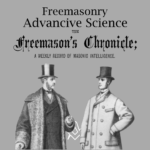 The Freemason's Chronicle - Freemasonry - an Advancive Science Is Freemasonry - an Advancive Science ? Not to confuse advancement with innovation. Has it been the case that Freemasonry's survival for 300 years plus is due to being an Advancive Science, tending to advance. First published in The Freemason's Chronicle 18 September 1875, addresses the same challenges then as now. |
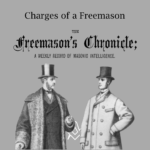 The Freemason's Chronicle - Charges Of A Freemason An interpretation of the "Charges of a Freemason", written Bro. Cornelius Moore and published in 1875, that introduce certain opinions that for some readers, will not sit well in contemporary times. - The Freemason's Chronicle, Sept. 11, 1875 |
 On The Order Of The Temple And Its Doctrine. THE Order of the Temple is divided into two great classes, denominated respectively the Order of the Temple and the Eastern Order. The Eastern Order gave birth to the Order of the Temple, and in the course of time has become an appendage of the latter. It is in ancient Egypt that we find the cradle of the Eastern Order. The Freemason's Chronicle, Sept. 4, 1875 |
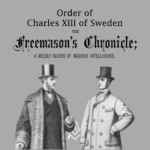 Order of Charles XIII of Sweden The following translation of the Manifesto of King JL Charles XIII of Sweden, on the occasion of his establishing the Masonic Order which bears his name, and of the Statutes of the said Order, may be interesting to our readers. The Freemason's Chronicle, Aug. 28, 1875 |
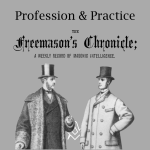 Most of our readers in the course of their experience, have doubtless met with enthusiastic brethren who take it for granted that a Mason can do no wrong. These enthusiasts are thoroughly convinced that the vast majority of those who join the Order are the most benevolent, the most moral, and the very noblest members of society. - The Freemason's Chronicle 10 July 1875 |
 An article investigating the relationship between masonry and citizenship. Are the principles of Freemasonry aligned with the freemason's claim to be a better citizen of the world? The Freemason's Chronicle - 19 June 1875 |
 A visitor must make clear his identity to the satisfaction of the Lodge he proposes to visit. More than once have we been asked to explain our views as to the reception of strangers in a Lodge. - The Freemason's Chronicle - 29 May 1875 |
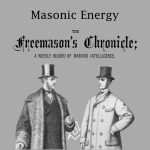 Is there reason in the accusation that Masonic energy looks only to a course of good feeds, when we can point to such grand results as have been achieved in these latter years, both in respect of the extension of our Order ? - 1May 1875 |
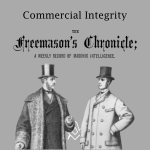 Implementing Freemasonry's peculiar system of morality in our day to day business affairs was the topic of this article, Commercial Integrity, first published in The Freemason's Chronicle - 8 May 1875 |
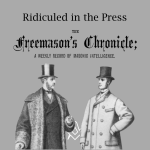 Ridicule has been somewhat illogically described as the test of truth. If it were so, Freemasonry ought to have perished long since. Two press reports from May 1875 covering the |
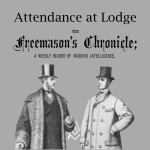 There are many things which Freemasonry will do for a man in the way of opening his mind and giving him larger and kindlier views of life, but Freemasonry itself, cannot eradicate the natural bias of the disposition. |
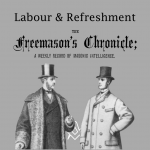 There is, we fear, too marked a tendency in very many Lodges to hasten through its labours, with a view to entering, as soon as possible, upon the business of refreshment. - The Freemason's Chronicle 17th April, 1875 |
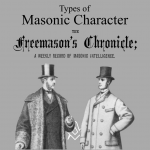 Another example that demonstrates that nothing really changes in Freemasonry. In an article the Types of Masonic Character published 145 years ago in The Freemason's Chronicle 10th April, 1875 |
 A brief history on the relationship between the British Monarchy and the craft - The Freemason's Chronicle 20th March , 1875 |
 What are the qualities of a convivial man and how does this dovetail perfectly in to Freemasonry ? 16th March, 1875 |
 A review of the "Sketch for the History of the Dionysian Artificers," a fragment, by Hyppoli to Joseph Da Costa - This little work may be regarded as, so to speak, the Holy Grail of Masonry. |
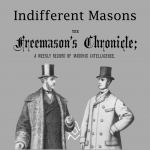 Nothing really changes, an article Indifferent Masons, From Le Monde Maçonnique 1874. Translation published in The Freemason's Chronicle 20th February, 1875 |
 In handling an intruder in the lodge, we endeavoured to show that a good Mason should be a gentleman, and a sincere man. The Freemason's Chronicle 20th February, 1875 |
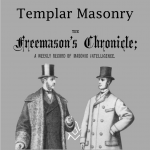 Templar Masonry - a historical aspect of the Religious and Military Order of the Temple published in The Freemason's Chronicle 13th February, 1875 |
 Secrecy perhaps the strongest objection urged by the enemies of the Masonic Order against its existence published in The Freemason's Chronicle 20th March 1875 |
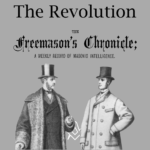 Freemasonry In The United States during And After The Revolution We take a look at Freemasonry in the United States during and after the Revolution first published in The Freemason's Chronicle - February 6, 1875 |
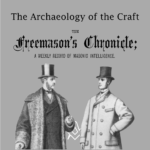 We take a look at the archaeological connection with the Craft, first published in The Freemason's Chronicle - January 30, 1875 |
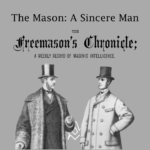 What it means to a Freemason to be a sincere man. Extract: first published in The Freemason's Chronicle - January 23, 1875 |
 What it means to a Freemason to be a citizen of the world ? First published in The Freemason's Chronicle - January 16, 1875 |
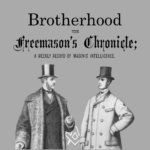 Brotherhood! In that one word what sympathetic associations arise. First published in The Freemason's Chronicle - January 9, 1875 |
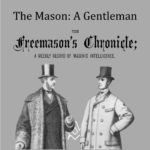 This opening article was written 145 years ago, yet it resonates with Freemasons today as it did then. First published in The Freemason's Chronicle, January 2, 1875, Issue 1 |
masonic knowledge
to be a better citizen of the world
share the square with two brothers

click image to open email app on mobile device







